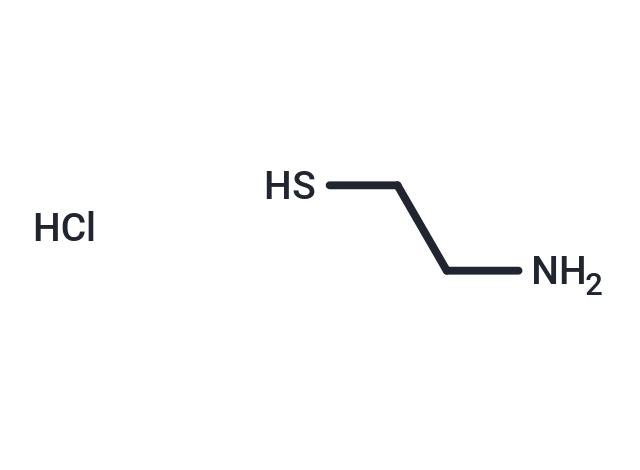Shopping Cart
Remove All Your shopping cart is currently empty
Your shopping cart is currently empty
Cysteamine hydrochloride is an orally administered small-molecule drug commonly used for the treatment of nephropathic cystinosis. It also functions as an antioxidant and is used in experimental studies to induce gastrointestinal disorders, duodenal ulcers, and kidney injury models in mice.

| Pack Size | Price | USA Warehouse | Global Warehouse | Quantity |
|---|---|---|---|---|
| 5 g | $29 | - | In Stock |
| Description | Cysteamine hydrochloride is an orally administered small-molecule drug commonly used for the treatment of nephropathic cystinosis. It also functions as an antioxidant and is used in experimental studies to induce gastrointestinal disorders, duodenal ulcers, and kidney injury models in mice. |
| In vitro | Cysteamine enhances intracellular glutathione (GSH) levels in cystinotic cells, effectively restoring their altered redox state and demonstrating antioxidant capabilities by increasing glutathione production, thus scavenging harmful OH and HOCl. It also mitigates increased apoptosis rates in cystinotic cells by counteracting the effects of elevated caspase 3 and protein kinase Cε activity. Furthermore, Cysteamine boosts the production of various heat shock proteins (HSP), notably murine Hsp40. It exhibits a dose-dependent mitigation of doxorubicin-induced death in cancer cells, including HeLa and B16 cells, without affecting cell survival on its own. Remarkably, it enhances the efficacy of doxorubicin in doxorubicin-resistant breast cancer cells, significantly increasing cell death. Additionally, Cysteamine (100 μM) not only heightens intracellular GSH levels but also improves the development of matured oocytes to the blastocyst stage in embryo cultures. [1][2] |
| In vivo | Cysteamine is introduced as a treatment for cystinosis by depleting lysosomal cystine. Cystamine can inhibit transglutaminase activity by binding to the cysteine in its active center. Cysteamine increases brain levels of brain-derived neurotrophic factor (BDNF), which is caused by the increased expression of the heat shock DNAJ-containing protein 1 (HSJ1). Cysteamine inhibits the formation of gastric and mammary tumors that are induced chemically or after irradiation, respectively. The administration of Cysteamine is also able to inhibit the metastasis of pancreatic cancer in a mouse model by decreasing the expression and activity of metalloproteinases. [1] |
| Synonyms | β-Mercaptoethylamine Hydrochloride, Thioethanolamine Hydrochloride, Cysteamine HCl, Bekaptan, 2-Mercaptoethylamine Hydrochloride, 2-Aminoethanethiol Hydrochloride |
| Molecular Weight | 113.61 |
| Formula | C2H7NS·HCl |
| Cas No. | 156-57-0 |
| Smiles | Cl.NCCS |
| Relative Density. | 0.75 |
| Storage | store under nitrogen | Powder: -20°C for 3 years | In solvent: -80°C for 1 year | Shipping with blue ice/Shipping at ambient temperature. | |||||||||||||||||||||||||||||||||||
| Solubility Information | Ethanol: 22 mg/mL (193.64 mM), Sonication is recommended. H2O: 21 mg/mL (184.84 mM), Sonication is recommended. DMSO: 71.43 mg/mL (628.73 mM), Sonication is recommended. | |||||||||||||||||||||||||||||||||||
| In Vivo Formulation | 10% DMSO+40% PEG300+5% Tween 80+45% Saline: 2 mg/mL (17.6 mM), Sonication is recommended. Please add the solvents sequentially, clarifying the solution as much as possible before adding the next one. Dissolve by heating and/or sonication if necessary. Working solution is recommended to be prepared and used immediately. The formulation provided above is for reference purposes only. In vivo formulations may vary and should be modified based on specific experimental conditions. | |||||||||||||||||||||||||||||||||||
Solution Preparation Table | ||||||||||||||||||||||||||||||||||||
H2O/Ethanol/DMSO
| ||||||||||||||||||||||||||||||||||||
| Size | Quantity | Unit Price | Amount | Operation |
|---|

Copyright © 2015-2025 TargetMol Chemicals Inc. All Rights Reserved.